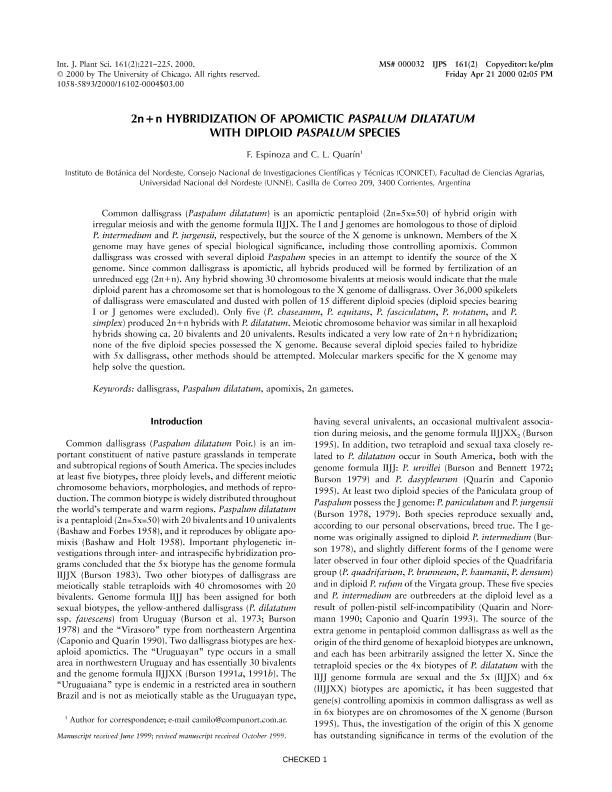Mostrar el registro sencillo del ítem
dc.contributor.author
Espinoza, Francisco

dc.contributor.author
Quarin, Camilo Luis

dc.date.available
2017-12-14T14:26:42Z
dc.date.issued
2000-04
dc.identifier.citation
Espinoza, Francisco; Quarin, Camilo Luis; 2 n + n hybridization of apomictic Paspalum dilatatum with diploid Paspalum species; University of Chicago Press; International Journal of Plant Sciences; 161; 2; 4-2000; 221-225
dc.identifier.issn
1058-5893
dc.identifier.uri
http://hdl.handle.net/11336/30569
dc.description.abstract
Common dallisgrass (Paspalum dilatatum) is an apomictic pentaploid (2n=5x=50) of hybrid origin with irregular meiosis and with the genome formula IIJJX. The I and J genomes are homologous to those of diploid P. intermedium and P. jurgensii, respectively, but the source of the X genome is unknown. Members of the X genome may have genes of special biological significance, including those controlling apomixis. Common dallisgrass was crossed with several diploid Paspalum species in an attempt to identify the source of the X genome. Since common dallisgrass is apomictic, all hybrids produced will be formed by fertilization of an unreduced egg (2n1n). Any hybrid showing 30 chromosome bivalents at meiosis would indicate that the male diploid parent has a chromosome set that is homologous to the X genome of dallisgrass. Over 36,000 spikelets of dallisgrass were emasculated and dusted with pollen of 15 different diploid species (diploid species bearing I or J genomes were excluded). Only five (P. chaseanum, P. equitans, P. fasciculatum, P. notatum, and P. simplex) produced 2n1n hybrids with P. dilatatum. Meiotic chromosome behavior was similar in all hexaploid hybrids showing ca. 20 bivalents and 20 univalents. Results indicated a very low rate of 2n1n hybridization; none of the five diploid species possessed the X genome. Because several diploid species failed to hybridize with 5x dallisgrass, other methods should be attempted. Molecular markers specific for the X genome may help solve the question.
dc.format
application/pdf
dc.language.iso
eng
dc.publisher
University of Chicago Press

dc.rights
info:eu-repo/semantics/openAccess
dc.rights.uri
https://creativecommons.org/licenses/by-nc-sa/2.5/ar/
dc.subject
Dallisgrass
dc.subject
Apomixis
dc.subject
2n Gametes
dc.subject
Biii Hybrids
dc.subject.classification
Otras Ciencias Biológicas

dc.subject.classification
Ciencias Biológicas

dc.subject.classification
CIENCIAS NATURALES Y EXACTAS

dc.title
2 n + n hybridization of apomictic Paspalum dilatatum with diploid Paspalum species
dc.type
info:eu-repo/semantics/article
dc.type
info:ar-repo/semantics/artículo
dc.type
info:eu-repo/semantics/publishedVersion
dc.date.updated
2017-12-04T17:29:55Z
dc.identifier.eissn
1537-5315
dc.journal.volume
161
dc.journal.number
2
dc.journal.pagination
221-225
dc.journal.pais
Estados Unidos

dc.journal.ciudad
Chicago
dc.description.fil
Fil: Espinoza, Francisco. Consejo Nacional de Investigaciones Científicas y Técnicas. Centro Científico Tecnológico Conicet - Nordeste. Instituto de Botánica del Nordeste. Universidad Nacional del Nordeste. Facultad de Ciencias Agrarias. Instituto de Botánica del Nordeste; Argentina
dc.description.fil
Fil: Quarin, Camilo Luis. Consejo Nacional de Investigaciones Científicas y Técnicas. Centro Científico Tecnológico Conicet - Nordeste. Instituto de Botánica del Nordeste. Universidad Nacional del Nordeste. Facultad de Ciencias Agrarias. Instituto de Botánica del Nordeste; Argentina
dc.journal.title
International Journal of Plant Sciences

dc.relation.alternativeid
info:eu-repo/semantics/altIdentifier/url/https://www.ncbi.nlm.nih.gov/pubmed/10777445
dc.relation.alternativeid
info:eu-repo/semantics/altIdentifier/url/http://www.journals.uchicago.edu/doi/abs/10.1086/314250
Archivos asociados
